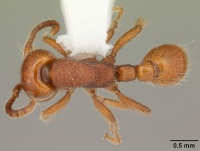Neivamyrmex carolinensis
| Neivamyrmex carolinensis | |
|---|---|

| |
| Scientific classification | |
| Kingdom: | Animalia |
| Phylum: | Arthropoda |
| Class: | Insecta |
| Order: | Hymenoptera |
| Family: | Formicidae |
| Subfamily: | Dorylinae |
| Genus: | Neivamyrmex |
| Species: | N. carolinensis |
| Binomial name | |
| Neivamyrmex carolinensis (Emery, 1894) | |
This species nests in the soil or under stones on rocky hillsides (in NM). Nests are large, up to 50,000 workers. Foragers are rarely seen above the ground, as they are active nocturnally. Flights occur in May and June. Trail pheromones are used in foraging. This is the only species known to be polygynous (multiple queens in a nest). Workers in laboratory nests with gynes present live longer than workers without the gyne. (Mackay and Mackay 2002)
| At a Glance | • Polygynous |
Identification
This species is unusual among our species of Neivamyrmex, in that the presence of a distinct eye facet is variable, present in some individuals, absent in others. Generally, a facet is present in larger individuals, but even this is subject to variation. This feature is shared with its sister species, Neivamyrmex kiowapache. (Snelling and Snelling 2007)
The dorsum of the head of the worker is smooth and glossy, with scattered piligerous (hair bearing) punctures. The mesosoma, petiole, and postpetiole are mostly smooth, and some areas are distinctly glossy. The node of the petiole is nearly square in shape, as seen from above. The eye is cellus-like, with a definite cornea. (Mackay and Mackay 2002)
Keys including this Species
Distribution
Virginia and North Carolina south to Florida, west to Tennessee and Louisiana. Neivamyrmex carolinensis is a wide ranging eastern species. Long considered to extend into the central and western United States as far as Arizona, it is now known that the populations west of the Mississippi River belong to a hitherto unrecognized sibling species. That species is described below as Neivamyrmex kiowapache. We are unable to confirm the presence of this species in Nebraska and Ohio (M. R. Smith, 1942) nor have we seen any specimens from Louisiana. (Snelling and Snelling 2007)
Latitudinal Distribution Pattern
Latitudinal Range: 37.383° to 25.106413°.
| North Temperate |
North Subtropical |
Tropical | South Subtropical |
South Temperate |
- Source: AntMaps
Distribution based on Regional Taxon Lists
Nearctic Region: United States (type locality).
Neotropical Region: Mexico.
Distribution based on AntMaps
Distribution based on AntWeb specimens
Check data from AntWeb
Countries Occupied
| Number of countries occupied by this species based on AntWiki Regional Taxon Lists. In general, fewer countries occupied indicates a narrower range, while more countries indicates a more widespread species. |

|
Estimated Abundance
| Relative abundance based on number of AntMaps records per species (this species within the purple bar). Fewer records (to the left) indicates a less abundant/encountered species while more records (to the right) indicates more abundant/encountered species. |

|
Habitat
Pine Forest.
Biology
Atchison & Lucky (2022) found that this species, as expected, does not remove seeds.
Association with Other Organisms
 Explore: Show all Associate data or Search these data. See also a list of all data tables or learn how data is managed.
Explore: Show all Associate data or Search these data. See also a list of all data tables or learn how data is managed.
- This species is a host for the diapriid wasp Myrmecopria mellea (a parasite) (www.diapriid.org).
- This species is a host for the diapriid wasp Apopria sp. (a parasite) (www.diapriid.org) (potential host).
- This species is a associate (details unknown) for the phorid fly Xanionotum hystrix (a associate (details unknown)) (Quevillon, 2018).
- This species is a associate (details unknown) for the phorid fly Xanionotum wasmanni (a associate (details unknown)) (Quevillon, 2018).
Life History Traits
- Queen number: polygynous (Rissing and Pollock, 1988; Frumhoff & Ward, 1992)
Castes
Worker
 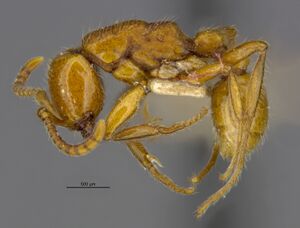  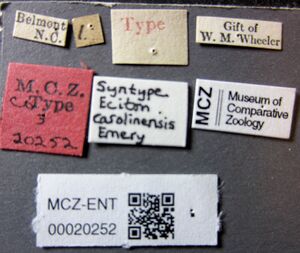
| |
| . | Owned by Museum of Comparative Zoology. |
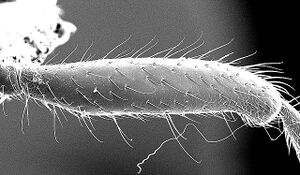   
| |
| . | |
Images from AntWeb
  
| |
| Worker. Specimen code casent0104130. Photographer April Nobile, uploaded by California Academy of Sciences. | Owned by ABS, Lake Placid, FL, USA. |
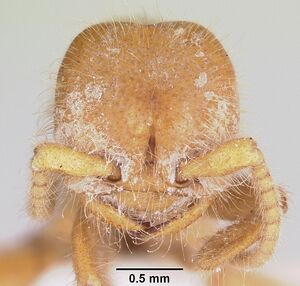
| |
| Queen (alate/dealate). Specimen code casent0104856. Photographer April Nobile, uploaded by California Academy of Sciences. | Owned by CAS, San Francisco, CA, USA. |
Queen
Images from AntWeb
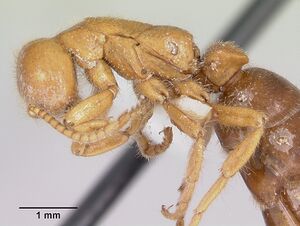    
| |
| Queen (alate/dealate). Specimen code casent0104856. Photographer April Nobile, uploaded by California Academy of Sciences. | Owned by CAS, San Francisco, CA, USA. |
Male
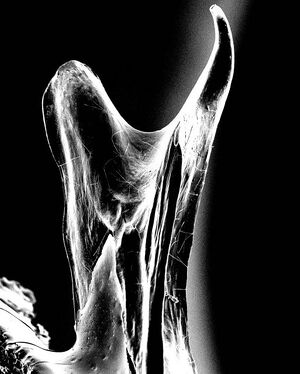 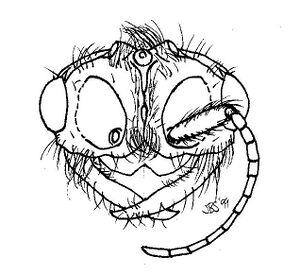 
| |
| . | |
Images from AntWeb
 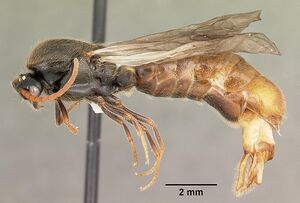  
| |
| Male (alate). Specimen code casent0104129. Photographer April Nobile, uploaded by California Academy of Sciences. | Owned by ABS, Lake Placid, FL, USA. |
Nomenclature
The following information is derived from Barry Bolton's Online Catalogue of the Ants of the World.
- carolinensis. Eciton (Acamatus) carolinense Emery, 1894c: 184 (diagnosis in key) (w.) U.S.A. (North Carolina).
- Type-material: syntype workers (number not stated).
- Type-locality: U.S.A.: North Carolina, Belmont (Pergande?) .
- Type-depositories: AMNH, MCZC, MSNG.
- Emery, 1895c: 259 (w.); Wheeler, W.M. 1921d: 314 (q.m.).
- Combination in E. (Neivamyrmex): Smith, M.R. 1942c: 564;
- combination in Neivamyrmex: Borgmeier, 1953: 6.
- Status as species: Emery, 1895c: 259 (description), Wheeler, W.M. 1904e: 300; Emery, 1910b: 24; Wheeler, W.M. 1910g: 562; Wheeler, W.M. 1921d: 314; Smith, M.R. 1928b: 245; Dennis, 1938: 278; Smith, M.R. 1938b: 158; Smith, M.R. 1942c: 564 (redescription); Creighton, 1950a: 71; Smith, M.R. 1951a: 780; Borgmeier, 1955: 507 (redescription); Carter, 1962a: 6 (in list); Smith, M.R. 1967: 345; Watkins, 1971: 94 (in key); Watkins, 1972: 350 (in key); Hunt & Snelling, 1975: 20; Watkins, 1976: 16 (in key); Smith, D.R. 1979: 1330; Watkins, 1985: 483 (in key); Mackay, Lowrie, et al. 1988: 87; Deyrup, et al. 1989: 94; Bolton, 1995b: 288; Mackay & Mackay, 2002: 55; Deyrup, 2003: 45; Coovert, 2005: 31; MacGown & Forster, 2005: 67; Snelling, G.C. & Snelling, 2007: 468; Deyrup, 2017: 37.
- Distribution: U.S.A.
Unless otherwise noted the text for the remainder of this section is reported from the publication that includes the original description.
Description
Worker
Smith (1942) - Major Length 3-4 mm.
Head scarcely longer than broad, narrowed posteriorly. Posterior corners of head, from above, feebly produced, bluntly angular and not outwardly curved as in wheeleri (=Neivamyrmex harrisii). Eye ocellus like, distinct, but not large. Mandible constricted at base, then abruptly enlarging on its superior border to form an angular tooth, margin between tooth and masticatory border straight or feebly excised; masticatory border oblique, with three or four irregular teeth on its upper half. Scape robust, approximately three and one-third times as long as its greatest width; scarcely surpassing posterior border of eye; funiculus very noticeably incrassate, all segments except first and last clearly broader than long, last segment as long as combined length of two preceding segments. Frontal carina, from above, forming only a very narrow and indistinct flange in front of antennal socket. Pronotum without sharp transverse carina of wheeleri, but often with feeble indication of a carina when examined from proper direction. Promesonotum, in profile, forming a gently convex, continuous arch very slightly higher than base of epinotum; meso-epinotal suture shallow but distinct; base and declivity of epinotum subequal, the two surfaces meeting to form a bluntly rounded angle, closely approaching a right angle. Petiolar node robust, subquadrate, scarcely longer than broad (approximately five-sixths as broad as long). Peduncle with anteroventral tooth. Postpetiole shorter than petiole but broader; broader than long, broadest posteriorly.
Head, propleura, legs, dorsum of postpetiole, and gaster smooth and shining. Punctures on head sparse, scattered, distinct. Mandible with longitudinal striae in addition to coarse, scattered punctures. Thoracic dorsum subopaque, reticulately shagreened, reticulations interspersed with coarse, scattered, foveolate punctures; punctures seen better in some lights than in others. Meso- and metapleura subopaque, with coarse punctures. Petiole sculptured somewhat as thorax but more feebly so.
Hairs light yellowish or grayish, moderately abundant, of variable length, sub erect to erect.
Yellowish brown to reddish brown, with head and thorax darker. Mandible usually darker than body.
Queen
Smith (1942) - Length 9-13 mm.
Head approximately as long as broad, with gently convex sides, well-rounded posterior corners, and very indistinctly or not emarginate posterior border. Eye extremely small, indistinct, represented by a very pale spot. Mandible long, slender, acute at apex. Scape curved, robust, rather short, slightly less than half the length of the head. Region adjacent and also somewhat posterior to frontal area with a strong, transverse, angular protuberance. A longitudinal, median groove extending posteriorly from clypeus, much broadened above the angular protuberance and extending well back on vertex. External surface of clypeus at most weakly concave, middle of anterior border not deeply but distinctly excised. Dorsal surface of head, from above, lacking median impression anterior to the occipital border, and lateral impression on each side anterior to posterior corner as in nigrescens; head thus viewed, although emarginate behind, not having an extended appearance, and the posterior corners broadly and evenly rounded, not produced. Thorax, from above, approximately two and one-fifth times as long as broad; wider in proportion to its length than thorax of Neivamyrmex opacithorax, wheeleri, and Neivamyrmex nigrescens. Metanotum and epinotum subequal in width, distinctly wider than other areas of thorax. Promesonotal suture obsolete, mesometanotal and metaepinotal sutures fairly distinct. Pronotum convex, not perceptibly marginate anteriorly or laterally. Mesonotum lacking median, longitudinal impression. Epinotum wider than long, with rather distinct, median impression. Thorax, in profile, less than two and four-tenths times as long as high, highest and most convex dorsally in region of promesonotal suture, lowest or most depressed in vicinity of meta-epinotal suture. Petiole, in profile, higher than epinotum; with a prominent tooth beneath somewhat similar to that of opacithorax but smaller; distinctly broader than long, very slightly broader anteriorly than posteriorly, with very shallow and narrow median impression.
Body and appendages, except funiculi and tarsi, shining. Thorax with scattered, fairly distinct to distinct punctures; neither head nor thorax with dense granulate shagreening between punctures as in opacithorax and nigrescens.
Hairs on head, thorax, and petiole moderately abundant, short; longer on gula, mandibles, clypeus, scape, and legs.
Light yellowish brown to brown; gaster usually darker than head or thorax.
Male
Smith (1942) - Length 9-9.25 mm.
Head approximately one and eight-tenths times as broad as long; posterior border rounded but almost obscured by large transverse ridge above each antennal socket. Eye small, convex, not strongly protuberant. Ocelli remarkably small, placed on low protuberance, which is only slightly elevated above general surface of head; lateral ocellus far removed from eye, space between them as great as or greater than space between the lateral ocelli. Frontal carinae converging posteriorly, with distinct median groove between them, the groove interrupted above at level of frontal ridge. Scape approximately as long as first 3 funicular segments combined; funiculus subfiliform. Mandible remarkably elongate and slender, at least 5 times as long as broad, apex blunt. Head, from above, well rounded behind eyes, with posterior corners blending into eyes; no occipital flange. A transverse groove behind the ridge above antennal socket. Eye, in profile, small, narrowed above, failing to occupy all of side of head, there being a small area dorsad and ventrad of eye and a much larger area posterodorsad; head behind ocelli convex. Thorax, in profile, approximately one and one-half times as long as high; slightly projecting anteriorly over head. Prothorax with a very distinct transverse impression anteriorly. Mesonotum with anteromedian and parapsidal lines. Epinotal declivity strongly concave. Legs slender. Tarsal claws weakly toothed. Petiole, from above, approximately one and one-half times as broad as long. Gaster slender, compressed. Paramere not characteristic enough to be clearly described.
Mandible with scattered but distinct punctures. Dorsal surface of head for the most part shining. Thorax with numerous coarse punctures, those of posterior part of mesonotum, scutellum, and sides of thorax largest and most distinct. Punctation of gaster coarse and dense enough to dull somewhat its luster and give gaster a rather sub opaque appearance.
Hairs yellowish, dense, appressed; longest on head, appendages, sides and venter of thorax, petiole, and gaster.
Head, thorax, and petiole black; gaster deep reddish brown. Funiculi and tarsi lighter.
Type Material
Smith (1942) - Belmont, Gaston County, N. C., P. J. Schmitt. Cotypes National Museum of Natural History
Worker Morphology
 Explore: Show all Worker Morphology data or Search these data. See also a list of all data tables or learn how data is managed.
Explore: Show all Worker Morphology data or Search these data. See also a list of all data tables or learn how data is managed.
- Caste: monomorphic
References
- Atchison, R. A., Lucky, A. 2022. Diversity and resilience of seed-removing ant species in Longleaf Sandhill to frequent fire. Diversity 14, 1012 (doi:10.3390/d14121012).
- Borgmeier, T. 1953. Vorarbeiten zu einer Revision der neotropischen Wanderameisen. Stud. Entomol. 2: 1-51 (page 6, Combination in Neivamyrmex)
- Borgmeier, T. 1955. Die Wanderameisen der neotropischen Region. Stud. Entomol. 3: 1-720 (page 507, see also)
- Davis, T. 2009. The ants of South Carolina (thesis, Clemson University).
- Emery, C. 1894d. Studi sulle formiche della fauna neotropica. VI-XVI. Bull. Soc. Entomol. Ital. 26: 137-241 (page 184, (diagnosis in key) worker described)
- Ivanov, K. 2019. The ants of Ohio (Hymenoptera, Formicidae): an updated checklist. Journal of Hymenoptera Research 70: 65–87 (doi:10.3897@jhr.70.35207).
- Liberti, J., Sapountzis, P., Hansen, L.H., Sørensen, S.J., Adams, R.M.M., Boomsma, J.J. 2015. Bacterial symbiont sharing in Megalomyrmex social parasites and their fungus-growing ant hosts. Molecular Ecology 24, 3151–3169 (doi:10.1111/MEC.13216).
- MacGown, J.A., Booher, D., Richter, H., Wetterer, J.K., Hill, J.G. 2021. An updated list of ants of Alabama (Hymenoptera: Formicidae) with new state records. Transactions of the American Entomological Society 147: 961-981 (doi:10.3157/061.147.0409).
- Mackay, W.P. & Mackay, E.E. 2002. The Ants of New Mexico: 400 pp. Edwin Mellen Press, Lewiston, N.Y.
- Mizuno, R., Suttiprapan, P., Jaitrong, W., Yamada, A., Ito, F. 2021. Colony composition, phasic reproduction, and queen–worker dimorphism of an oriental non-army ant doryline Cerapachys sulcinodis species complex in northern Thailand. Insectes Sociaux (doi:10.1007/s00040-021-00841-5).
- Snelling, G. C.; Snelling, R. R. 2007. New synonymy, new species, new keys to Neivamyrmex army ants of the United States. In Snelling, R. R., B. L. Fisher, and P. S. Ward (eds). Advances in ant systematics (Hymenoptera: Formicidae): homage to E. O. Wilson - 50 years of contributions. Memoirs of the American Entomological Institute 80:459-550. PDF
- Smith, M. R. 1942c. The legionary ants of the United States belonging to Eciton subgenus Neivamyrmex Borgmeier. Am. Midl. Nat. 27: 537-590 (page 564, Combination in E. (Neivamyrmex))
- Wheeler, W. M. 1921d. Observations on army ants in British Guiana. Proc. Am. Acad. Arts Sci. 56: 291-328 (page 314, queen, male described)
References based on Global Ant Biodiversity Informatics
- Annotated Ant Species List Ordway-Swisher Biological Station. Downloaded at http://ordway-swisher.ufl.edu/species/os-hymenoptera.htm on 5th Oct 2010.
- Bestelmeyer B. T., and J. A. Wiens. 2001. Local and regional-scale responses of ant diversity to a semiarid biome transition. Ecography 24: 381-392.
- Borgmeier T. 1953. Vorarbeiten zu einer Revision der neotropischen Wanderameisen. Studia Entomologica 2: 1-51.
- Borgmeier T. 1955. Die Wanderameisen der neotropischen Region. Studia Entomologica 3: 1-720.
- Coovert, G.A. 2005. The Ants of Ohio (Hymenoptera: Formicidae) Ohio Biological Survey Bulletin New Series Volume 15(2):1-196
- Deyrup M. 2016. Ants of Florida: identification and natural history. CRC Press, 423 pages.
- Deyrup M., C. Johnson, G. C. Wheeler, J. Wheeler. 1989. A preliminary list of the ants of Florida. Florida Entomologist 72: 91-101
- Deyrup M., L. Deyrup, and J. Carrel. 2013. Ant Species in the Diet of a Florida Population of Eastern Narrow-Mouthed Toads, Gastrophryne carolinensis. Southeastern Naturalist 12(2): 367-378.
- Deyrup, M. 2003. An updated list of Florida ants (Hymenoptera: Formicidae). Florida Entomologist 86(1):43-48.
- DuBois M. B. 1985. Distribution of ants in Kansas: subfamilies Ponerinae, Ecitoninae, and Myrmicinae (Hymenoptera: Formicidae). Sociobiology 11: 153-274
- DuBois M. B. 1985. Distribution of ants in Kansas: subfamilies Ponerinae, Ecitoninae, and Myrmicinae (Hymenoptera: Formicidae). Sociobiology 11: 153-275
- DuBois M. B. 1988. Distribution of army ants (Hymenoptera: Formicidae) in Illinois. Entomological News 99: 157-160.
- Forster J.A. 2005. The Ants (hymenoptera: Formicidae) of Alabama. Master of Science, Auburn University. 242 pages.
- Guénard B., K. A. Mccaffrey, A. Lucky, and R. R. Dunn. 2012. Ants of North Carolina: an updated list (Hymenoptera: Formicidae). Zootaxa 3552: 1-36.
- Ivanov, K. 2019. The ants of Ohio (Hymenoptera, Formicidae): an updated checklist. Journal of Hymenoptera Research 70: 65–87.
- Johnson C. 1986. A north Florida ant fauna (Hymenoptera: Formicidae). Insecta Mundi 1: 243-246
- Johnson R. Personnal Database. Accessed on February 5th 2014 at http://www.asu.edu/clas/sirgtools/resources.htm
- MacGown J. A., J. G. Hill, and R. L. Brown. 2010. Native and exotic ant in Mississippi state parks. Proceedings: Imported Fire Ant Conference, Charleston, South Carolina, March 24-26, 2008: 74-80.
- MacGown, J. 2011. Ants of Tennessee (species list). Accessed 21 April 2011
- MacGown, J.A and J.A. Forster. 2005. A preliminary list of the ants (Hymenoptera: Formicidae) of Alabama, U.S.A. Entomological News 116(2):61-74
- MacGown, J.A. and JV.G. Hill. Ants of the Great Smoky Mountains National Park (Tennessee and North Carolina).
- Mackay W. P., and E. E. Mackay. 2002. The ants of New Mexico (Hymenoptera: Formicidae). Lewiston, New York: Edwin Mellen Press, 400 pp.
- Mackay, W., D. Lowrie, A. Fisher, E. Mackay, F. Barnes and D. Lowrie. 1988. The ants of Los Alamos County, New Mexico (Hymenoptera: Formicidae). pages 79-131 in J.C. Trager, editor, Advances in Myrmecololgy.
- Smith M. R. 1942. The legionary ants of the United States belonging to Eciton subgenus Neivamyrmex Borgmeier. American Midland Naturalist 27: 537-590.
- Snelling G. C. and R. R. Snelling. 2007. New synonymy, new species, new keys to Neivamyrmex army ants of the United States. Memoirs of the American Entomological Institute 80: 459-550
- Van Pelt A. F. 1966. Activity and density of old-field ants of the Savannah River Plant, South Carolina. Journal of the Elisha Mitchell Scientific Society 82: 35-43.
- Van Pelt A., and J. B. Gentry. 1985. The ants (Hymenoptera: Formicidae) of the Savannah River Plant, South Carolina. Dept. Energy, Savannah River Ecology Lab., Aiken, SC., Report SRO-NERP-14, 56 p.
- Watkins J. F., II 1976. The identification and distribution of New World army ants (Dorylinae: Formicidae). Waco, Texas: Baylor University Press, 102 pp
- Watkins J. F., II 1985. The identification and distribution of the army ants of the United States of America (Hymenoptera, Formicidae, Ecitoninae). Journal of the Kansas Entomological Society 58: 479-502.
- Wheeler W. M. 1904. The ants of North Carolina. Bulletin of the American Museum of Natural History. 20: 299-306.
- Pages using DynamicPageList3 parser function
- Polygynous
- North temperate
- North subtropical
- Diapriid wasp Associate
- Host of Myrmecopria mellea
- Host of Apopria sp.
- Phorid fly Associate
- Host of Xanionotum hystrix
- Host of Xanionotum wasmanni
- Species
- Extant species
- Formicidae
- Dorylinae
- Neivamyrmex
- Neivamyrmex carolinensis
- Dorylinae species
- Neivamyrmex species
- Ssr

